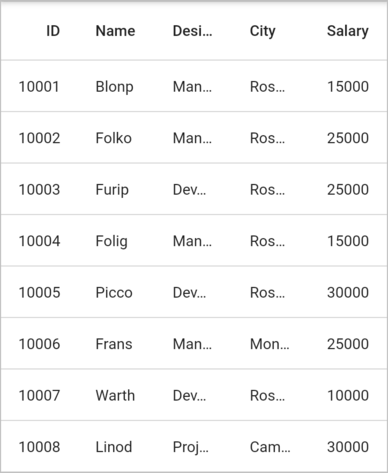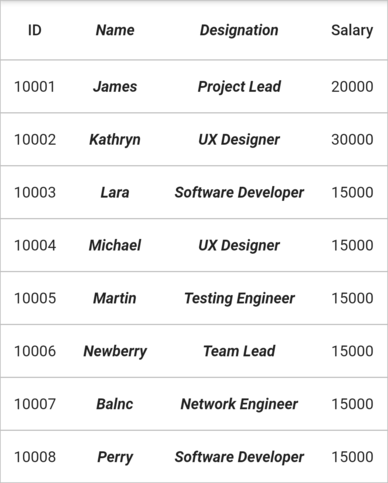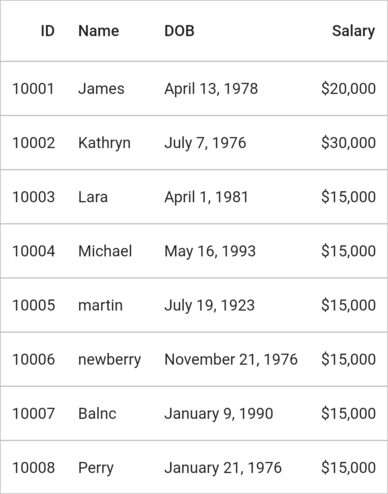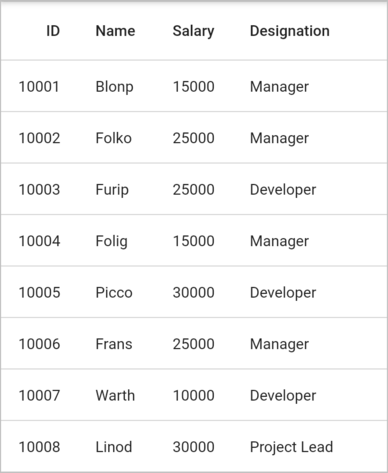Column sizing in Flutter DataGrid (SfDataGrid)
22 May 202524 minutes to read
SfDataGrid allows setting the column widths based on certain logic using the SfDataGrid.columnWidthMode or GridColumn.columnWidthMode property. The following is the list of predefined column sizing options available.
| Mode | Description |
|---|---|
| ColumnWidthMode.auto | Calculates the width of column based on GridColumn.columName and DataGridCell.value properties. So, the header and cell contents are not truncated. |
| ColumnWidthMode.fitByCellValue | Calculates the width of column based on DataGridCell.value property. So, the cell contents are not truncated. |
| ColumnWidthMode.fitByColumnName | Calculates the width of column based on GridColumn.columName property. So, the header contents are not truncated. |
| ColumnWidthMode.lastColumnFill | Applies default Column width to all the columns except last column which is visible and the remaining width from total width of SfDataGrid is set to last column. |
| ColumnWidthMode.fill | Divides the total width equally for columns. |
| ColumnWidthMode.none | No sizing. Default column width or defined width set to column. |
NOTE
ColumnWidthMode will not work when the column width defined explicitly.columnWidthModecalculates column width based on miniumWidth and maximumWidth properties.
The following example shows how to set the width equally for columns based on the viewport size.
@override
Widget build(BuildContext context) {
return Scaffold(
body: SfDataGrid(
source: _employeeDataSource,
columnWidthMode: ColumnWidthMode.fill,
columns: <GridColumn>[
GridColumn(
columnName: 'id',
label: Container(
padding: EdgeInsets.symmetric(horizontal: 16.0),
alignment: Alignment.centerRight,
child: Text(
'ID',
overflow: TextOverflow.ellipsis,
))),
GridColumn(
columnName: 'name',
label: Container(
padding: EdgeInsets.symmetric(horizontal: 16.0),
alignment: Alignment.centerLeft,
child: Text(
'Name',
overflow: TextOverflow.ellipsis,
))),
GridColumn(
columnName: 'designation',
label: Container(
padding: EdgeInsets.symmetric(horizontal: 16.0),
alignment: Alignment.centerLeft,
child: Text(
'Designation',
overflow: TextOverflow.ellipsis,
))),
GridColumn(
columnName: 'city',
label: Container(
padding: EdgeInsets.symmetric(horizontal: 16.0),
alignment: Alignment.centerLeft,
child: Text(
'city',
overflow: TextOverflow.ellipsis,
))),
GridColumn(
columnName: 'salary',
label: Container(
padding: EdgeInsets.symmetric(horizontal: 16.0),
alignment: Alignment.centerRight,
child: Text(
'Salary',
overflow: TextOverflow.ellipsis,
)))
]));
}NOTE
TheGridColumn.columnWidthModetakes higher priority than theSfDataGrid.columnWidthMode.

Consider all the rows to calculate the autofit size
By default, the autofit calculation is performed for only visible rows. You can use the SfDataGrid.columnWidthCalculationRange property as ColumnWidthCalculationRange.allRows to perform the autofit calculation for all the available rows.
@override
Widget build(BuildContext context) {
return SfDataGrid(
source: _employeeDataSource,
columnWidthMode: ColumnWidthMode.auto,
columnWidthCalculationRange: ColumnWidthCalculationRange.allRows,
columns: <GridColumn>[
GridColumn(
columnName: 'ID',
label: Container(
padding: EdgeInsets.all(16.0),
alignment: Alignment.centerRight,
child: Text(
'ID',
softWrap: false,
))),
GridColumn(
columnName: 'Name',
label: Container(
padding: EdgeInsets.all(16.0),
alignment: Alignment.centerLeft,
child: Text(
'Name',
softWrap: false,
))),
GridColumn(
columnName: 'Designation',
label: Container(
padding: EdgeInsets.all(16.0),
alignment: Alignment.centerLeft,
child: Text(
'Designation',
softWrap: false,
))),
GridColumn(
columnName: 'Salary',
label: Container(
padding: EdgeInsets.all(16.0),
alignment: Alignment.centerRight,
child: Text(
'Salary',
softWrap: false,
)))
]);
}Change the padding value for autofit calculation
By default, the EdgeInsets.all(16.0) is added with the auto width or height value. You can change the padding for specific columns by using the GridColumn.autoFitPadding property.
NOTE
GridColumn.autoFitPaddingis applicable for header cell also.
@override
Widget build(BuildContext context) {
return SfDataGrid(
source: _employeeDataSource,
columnWidthMode: ColumnWidthMode.auto,
columns: <GridColumn>[
GridColumn(
columnName: 'id',
autoFitPadding: EdgeInsets.all(10.0),
label: Container(
padding: EdgeInsets.all(10.0),
alignment: Alignment.centerRight,
child: Text(
'ID',
softWrap: false,
))),
GridColumn(
columnName: 'name',
autoFitPadding: EdgeInsets.all(10.0),
label: Container(
padding: EdgeInsets.all(10.0),
alignment: Alignment.centerLeft,
child: Text(
'Name',
softWrap: false,
))),
GridColumn(
columnName: 'designation',
autoFitPadding: EdgeInsets.all(10.0),
label: Container(
padding: EdgeInsets.all(10.0),
alignment: Alignment.centerLeft,
child: Text(
'Designation',
softWrap: false,
))),
GridColumn(
columnName: 'salary',
autoFitPadding: EdgeInsets.all(10.0),
label: Container(
padding: EdgeInsets.all(10.0),
alignment: Alignment.centerRight,
child: Text(
'Salary',
softWrap: false,
)))
]);
}
class EmployeeDataSource extends DataGridSource {
EmployeeDataSource({required List<Employee> employees}) {
_employeeData = employees
.map<DataGridRow>((e) => DataGridRow(cells: [
DataGridCell<int>(columnName: 'ID', value: e.id),
DataGridCell<String>(columnName: 'Name', value: e.name),
DataGridCell<String>(
columnName: 'Designation', value: e.designation),
DataGridCell<int>(columnName: 'Salary', value: e.salary),
]))
.toList();
}
List<DataGridRow> _employeeData = [];
@override
List<DataGridRow> get rows => _employeeData;
@override
DataGridRowAdapter buildRow(DataGridRow row) {
return DataGridRowAdapter(
cells: row.getCells().map<Widget>((cell) {
return Container(
alignment: Alignment.center,
// The autoFitPadding and the cell padding value should be same.
padding: EdgeInsets.all(10.0),
child: Text(cell.value.toString()),
);
}).toList());
}
}
Autofit calculation based on different TextStyle
By default, the cell width is calculated based on the default text style. To calculate the cell width based on different TextStyle, just override the computeHeaderCellWidth method for the header and computeCellWidth method for the cell and return the super method with the required TextStyle.
final CustomColumnSizer _customColumnSizer = CustomColumnSizer();
@override
Widget build(BuildContext context) {
return SfDataGrid(
source: _employeeDataSource,
columnSizer: _customColumnSizer,
columnWidthMode: ColumnWidthMode.auto,
columns: <GridColumn>[
GridColumn(
columnName: 'ID',
autoFitPadding: EdgeInsets.all(12.0),
label: Container(
padding: EdgeInsets.all(12.0),
alignment: Alignment.center,
child: Text(
'ID',
))),
GridColumn(
columnName: 'Name',
autoFitPadding: EdgeInsets.all(12.0),
label: Container(
padding: EdgeInsets.all(12.0),
alignment: Alignment.center,
child: Text(
'Name',
style: TextStyle(
fontWeight: FontWeight.bold, fontStyle: FontStyle.italic),
))),
GridColumn(
columnName: 'Designation',
autoFitPadding: EdgeInsets.all(12.0),
label: Container(
padding: EdgeInsets.all(12.0),
alignment: Alignment.center,
child: Text(
'Designation',
overflow: TextOverflow.ellipsis,
style: TextStyle(
fontWeight: FontWeight.bold, fontStyle: FontStyle.italic),
))),
GridColumn(
columnName: 'Salary',
autoFitPadding: EdgeInsets.all(12.0),
label: Container(
padding: EdgeInsets.all(12.0),
alignment: Alignment.center,
child: Text('Salary'))),
]);
}
class EmployeeDataSource extends DataGridSource {
EmployeeDataSource({required List<Employee> employees}) {
_employeeData = employees
.map<DataGridRow>((e) => DataGridRow(cells: [
DataGridCell<int>(columnName: 'ID', value: e.id),
DataGridCell<String>(columnName: 'Name', value: e.name),
DataGridCell<String>(
columnName: 'Designation', value: e.designation),
DataGridCell<int>(columnName: 'Salary', value: e.salary),
]))
.toList();
}
List<DataGridRow> _employeeData = [];
@override
List<DataGridRow> get rows => _employeeData;
@override
DataGridRowAdapter buildRow(DataGridRow row) {
return DataGridRowAdapter(
cells: row.getCells().map<Widget>((e) {
return Container(
alignment: Alignment.center,
padding: EdgeInsets.all(12.0),
child: Text(e.value.toString(),
style: (e.columnName == 'Name' || e.columnName == 'Designation')
? TextStyle(
fontWeight: FontWeight.bold, fontStyle: FontStyle.italic)
: null));
}).toList());
}
}
class CustomColumnSizer extends ColumnSizer {
@override
double computeHeaderCellWidth(GridColumn column, TextStyle style) {
if (column.columnName == 'Name' || column.columnName == 'Designation') {
style =
TextStyle(fontWeight: FontWeight.bold, fontStyle: FontStyle.italic);
}
return super.computeHeaderCellWidth(column, style);
}
@override
double computeCellWidth(GridColumn column, DataGridRow row, Object? cellValue,
TextStyle textStyle) {
if (column.columnName == 'Name' || column.columnName == 'Designation') {
textStyle =
TextStyle(fontWeight: FontWeight.bold, fontStyle: FontStyle.italic);
}
return super.computeCellWidth(column, row, cellValue, textStyle);
}
}NOTE
Download the demo application from GitHub.

Autofit calculation based on the formatted value
The cell width is calculated by default based on the DataGridCell.value property. To autofit the cell width based on the displayed formatted value (This is, DateFormat and NumberFormat), simply override the computeCellWidth method and return the super method with the required cellValue.
import 'package:intl/intl.dart';
final CustomColumnSizer _customColumnSizer = CustomColumnSizer();
@override
Widget build(BuildContext context) {
return SfDataGrid(
source: _employeeDataSource,
columnSizer: _customColumnSizer,
columnWidthMode: ColumnWidthMode.fitByCellValue,
columns: <GridColumn>[
GridColumn(
columnName: 'ID',
label: Container(
padding: EdgeInsets.all(16.0),
alignment: Alignment.centerRight,
child: Text(
'ID',
softWrap: false,
))),
GridColumn(
columnName: 'Name',
label: Container(
padding: EdgeInsets.all(16.0),
alignment: Alignment.centerLeft,
child: Text(
'Name',
softWrap: false,
))),
GridColumn(
columnName: 'DOB',
label: Container(
padding: EdgeInsets.all(16.0),
alignment: Alignment.centerLeft,
child: Text(
'DOB',
softWrap: false,
))),
GridColumn(
columnName: 'Salary',
label: Container(
padding: EdgeInsets.all(16.0),
alignment: Alignment.centerRight,
child: Text(
'Salary',
softWrap: false,
)))
]);
}
class EmployeeDataSource extends DataGridSource {
EmployeeDataSource({required List<Employee> employees}) {
_employeeData = employees
.map<DataGridRow>((e) => DataGridRow(cells: [
DataGridCell<int>(columnName: 'ID', value: e.id),
DataGridCell<String>(columnName: 'Name', value: e.name),
DataGridCell<DateTime>(columnName: 'DOB', value: e.dob),
DataGridCell<int>(columnName: 'Salary', value: e.salary),
]))
.toList();
}
List<DataGridRow> _employeeData = [];
@override
List<DataGridRow> get rows => _employeeData;
@override
DataGridRowAdapter buildRow(DataGridRow row) {
return DataGridRowAdapter(
cells: row.getCells().map<Widget>((e) {
late String cellValue;
if (e.columnName == 'DOB') {
cellValue = DateFormat.yMMMMd('en_US').format(e.value);
} else if (e.columnName == 'Salary') {
cellValue =
NumberFormat.simpleCurrency(decimalDigits: 0).format(e.value);
} else {
cellValue = e.value.toString();
}
return Container(
alignment: Alignment.center,
padding: EdgeInsets.all(16.0),
child: Text(cellValue),
);
}).toList());
}
}
class CustomColumnSizer extends ColumnSizer {
@override
double computeCellWidth(GridColumn column, DataGridRow row, Object? cellValue,
TextStyle textStyle) {
if (column.columnName == 'DOB') {
cellValue = DateFormat.yMMMMd('en_US').format(cellValue as DateTime);
} else if (column.columnName == 'Salary') {
cellValue =
NumberFormat.simpleCurrency(decimalDigits: 0).format(cellValue);
}
return super.computeCellWidth(column, row, cellValue, textStyle);
}
}NOTE
Download the demo application from GitHub.

Fill the remaining width for any column
While setting SfDataGrid.columnWidthMode as lastColumnFill the remaining width is applied to the last column. The remaining width of a specific column can be applied by setting the GridColumn.columnWidthMode property.
@override
Widget build(BuildContext context) {
return Scaffold(
body: SfDataGrid(
source: _employeeDataSource,
columnWidthMode: ColumnWidthMode.lastColumnFill,
columns: <GridColumn>[
GridColumn(
columnName: 'id',
label: Container(
padding: EdgeInsets.symmetric(horizontal: 16.0),
alignment: Alignment.centerRight,
child: Text(
'ID',
overflow: TextOverflow.ellipsis,
))),
GridColumn(
columnName: 'name',
label: Container(
padding: EdgeInsets.symmetric(horizontal: 16.0),
alignment: Alignment.centerLeft,
child: Text(
'Name',
overflow: TextOverflow.ellipsis,
))),
GridColumn(
columnName: 'salary',
label: Container(
padding: EdgeInsets.symmetric(horizontal: 16.0),
alignment: Alignment.centerRight,
child: Text(
'Salary',
overflow: TextOverflow.ellipsis,
))),
GridColumn(
columnName: 'designation',
label: Container(
padding: EdgeInsets.symmetric(horizontal: 16.0),
alignment: Alignment.centerLeft,
child: Text(
'Designation',
overflow: TextOverflow.ellipsis,
)))
]));
}
The below example shows Name column is set as lastColumnFill mode.
@override
Widget build(BuildContext context) {
return Scaffold(
body: SfDataGrid(
source: _employeeDataSource,
columns: <GridColumn>[
GridColumn(
columnName: 'id',
label: Container(
padding: EdgeInsets.symmetric(horizontal: 16.0),
alignment: Alignment.centerRight,
child: Text(
'ID',
overflow: TextOverflow.ellipsis,
))),
GridColumn(
columnName: 'name',
columnWidthMode: ColumnWidthMode.lastColumnFill,
label: Container(
padding: EdgeInsets.symmetric(horizontal: 16.0),
alignment: Alignment.centerLeft,
child: Text(
'Name',
overflow: TextOverflow.ellipsis,
))),
GridColumn(
columnName: 'salary',
label: Container(
padding: EdgeInsets.symmetric(horizontal: 16.0),
alignment: Alignment.centerRight,
child: Text(
'Salary',
overflow: TextOverflow.ellipsis,
))),
GridColumn(
columnName: 'designation',
label: Container(
padding: EdgeInsets.symmetric(horizontal: 16.0),
alignment: Alignment.centerLeft,
child: Text(
'Designation',
overflow: TextOverflow.ellipsis,
)))
]));
}
Recalculating column widths when datasource is changed
By default, column widths are calculated based on the columnWidthMode property on the initial loading of the Datagrid. When the data source is changed for the same datagrid at run time, the Datagrid does not recalculate the column widths. To recalculate the column widths at run time when the data source is changed or data is updated, override the shouldRecalculateColumnWidths method and return true.
Returning true may impact performance as the column widths are recalculated again (whenever the notifyListeners is called). If you know that column widths will be the same whenever underlying data changes, return false from this method.
class EmployeeDataSource extends DataGridSource {
EmployeeDataSource({required List<Employee> employees}) {
dataGridRows = employees
.map<DataGridRow>((dataGridRow) => DataGridRow(cells: [
DataGridCell<int>(columnName: 'id', value: dataGridRow.id),
DataGridCell<String>(columnName: 'name', value: dataGridRow.name),
DataGridCell<String>(
columnName: 'designation', value: dataGridRow.designation),
DataGridCell<int>(
columnName: 'salary', value: dataGridRow.salary),
]))
.toList();
}
List<DataGridRow> dataGridRows = [];
@override
List<DataGridRow> get rows => dataGridRows;
@override
DataGridRowAdapter? buildRow(DataGridRow row) {
return DataGridRowAdapter(
cells: row.getCells().map<Widget>((dataGridCell) {
return Container(
alignment: (dataGridCell.columnName == 'id' ||
dataGridCell.columnName == 'salary')
? Alignment.centerRight
: Alignment.centerLeft,
padding: EdgeInsets.symmetric(horizontal: 16.0),
child: Text(
dataGridCell.value.toString(),
overflow: TextOverflow.ellipsis,
));
}).toList());
}
@override
bool shouldRecalculateColumnWidths() {
return true;
}
}